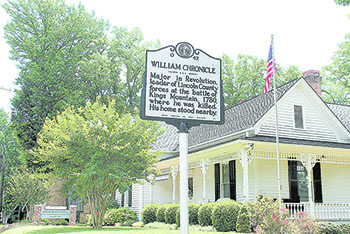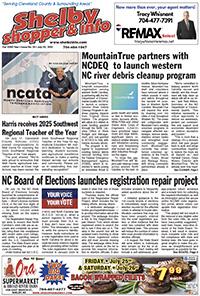 July 4th is just around the corner so let's stop and take a look at some of the local people and places that
played a big role in the founding of our nation.
Patterson Springs in southern Cleveland County is a quiet community with a long history. Six miles south of the crossroads of NC 226 and NC 180 is the former site of a Revolutionary War-era site once known as Graham's Fort. Now occupied by a house that is part modern and part antebellum, the "fort" was actually a large log cabin built by Colonel William Graham.
Graham was quite a character. In addition to being a strong proponent of liberty, he was also a delegate
to the Fifth Provincial Congress. In September 1780, Graham and his family and friends were attacked inside their fort by local Tories. In the ensuing fight, four Tories were wounded. The next month, Graham found himself fighting at Kings Mountain.
Next stop is the town of Grover. Located on US 29 near Grover are historical markers that pinpoint two places that British soldiers were in evidence during the Revolution. The first marker indicated where troops of Major Patrick Ferguson bivouacked on Oct. 4 and 5, 1780 before they made their way to Kings Mountain. The other marker points to the spot where Lord Cornwallis and his men entered North Carolina in January 1781 on their second invasion of North Carolina.
While in Grover, another interesting place to visit is the old Shiloh Presbyterian Church Cemetery. Located on a dirt road off Elm Street, the cemetery holds the remains of one of Cleveland County's most illustrious patriots, Colonel Frederick Hambright (1727-1817). Born in Germany, Hambright had prior to his service in the Revolution been an Indian fighter. A new marker at the entrance to Kings Mountain National Military Park on SC 216 touts some of Hambright's achievements.
Another hero of the Battle of Kings Mtn. is William Chronicle from Belmont. A NC Highway Historical marker on Catawba St. in front of the Belmont Historical Society (pictured) points out the fact that the home of Chronicle, leader of the "South Fork Boys" was once located nearby. Chronicle was killed in the battle.
In the city of Kings Mountain is another cemetery with Revolutionary War connections. Located off Afton Drive is a graveyard that contains the remains of patriot Preston Goforth (1739-1780). A native of Rutherford County, Goforth was killed in the Battle of Kings Mountain. In an interesting twist, Goforth had three brothers who were also killed in the battle-fighting on the side of Loyalists.
Leaving Kings Mountain on NC 161, go about two miles and turn left onto Long Creek Road. Near where the road crosses Long Creek is the Washington Iron Furnace. This furnace was used during the Revolution to manufacture cannonballs and other implements.
Outside Bessemer City in Gaston County is the Tryon Community. Created in 1769 by the colonial assembly, Tryon County once stretched from the shores of the Catawba River all the way to the mountains. Because it was named for one of King George's pals, Royal gubernator William Tryon, the county was dissolved in 1799 leaving only its name.
During the Revolution, citizens of the Tryon community areas got together and drew up a set of proclamations on August 14, 1775 that spelled out their displeasure at the way things were going between England and the colonies. Though the document didn't go quite as far as the Mecklenburg
Declaration of Independence, the Tryon Resolves nonetheless vowed that its drafters would fight for their freedoms if it came to that. While they were at it, the folks of Tryon also decided they would get muskets, powder and ammo from their patriotic friends in Charleston, SC. Today, a stone and bronze marker to the Tryon Resolves can be seen. The marker was erected by the DAR and lists the names of those who signed the document.
Near the Tryon community is Pasour Mountain. Just off NC 279, Pasour Mountain was originally known as LaBoone Mountain for the LaBoone family who lived there. During the Revolution, the LaBoones, who were Tories, sometimes sought shelter in a cave. Eventually they felt local patriots' displeasure and skeedaddled.
One of the best sources for information about places in North Carolina and their War of Independence connections is "Touring North Carolina's Revolutionary War Sites" by Daniel Barefoot. An attorney and resident of Lincolnton, Barefoot has gathered his vast knowledge of the Revolutionary period in our state together in a volume published by John F. Blair of Winston Salem.
Pictured: This NC Highway Historical marker on Catawba St., in front of the Belmont Historical Society points out the fact that the home of Chronicle, leader of the "South Fork Boys", was once located nearby. Chronicle was killed in the Battle of Kings Mountain.
Photo by Alan Hodge
By Alan Hodge
Alan@cfmedia.info |




